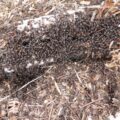by Sally Gregson
For months the brittle buds of small dicentras have been tucked away beneath the surface of the soil, biding their time. And now, in April, they are beginning to push up their seemingly delicate shoots, like long, glass beads, for us all to admire.
Despite their apparently fragile stems, dicentra are tough little plants that thrive in light shade beneath the shrubs in the garden. Dicentra formosa produces quantities of pink or cream lockets that dangle over pretty fern-like leaves in various shades of grey and green. Their foliage contrasts well with broad-leaved hostas, ferns and scalloped tiarellas to create a tapestry in a cool shady spot.
Dicentra formosa ‘Bacchanal’ has deep pink hearts above pearl-grey foliage throughout April, and D. formosa ‘Aurora’ has white lockets over silvery, divided leaves. They grow to about 30cm in flower and are perfectly hardy.
Their larger cousin, Dicentra spectabilis (Lamprocapnos spectabilis), has captured the imaginations of countless cottage gardeners over the years. It was doubtless a mischievous child that first discovered that if the two ‘tabs’ at the point of each heart are gently pulled apart, the central ‘lady’ will pop out of her ‘bath’.
It grows to about 60cm in light shade. Both the lower-growing D. formosa and D. eximea, usefully fill quite awkward, fairly dry shade, and the larger D. spectabilis occupies a similar corner.
By the autumn, dicentras are no longer visible, so it is wise to ensure their protection from questing trowels looking for an empty space. Perhaps a close liaison with a few ferns, or the foliage of exquisite autumn-flowering Tricyrtis will act as a safeguard. Or simply inserting a plant label almost completely will stay the hand and deter any interference. Add an organic mulch in autumn and you will ensure a delightful display from an exquisitely pretty plant throughout the spring.











Leave a Reply